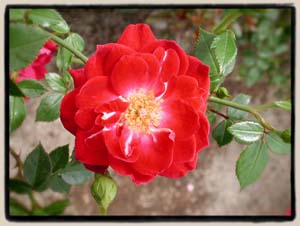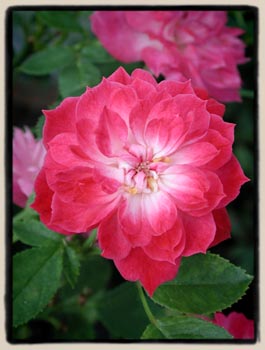|

What's
new
Albas
Bourbons
Centifolias
Chinas
Climbers
Damasks
English Roses
Gallicas
Hyb. Bracteatas
Hyb. Musks
Hyb. Perpetuals
Hybrid Teas
Miniatures
Modern Shrubs
Moss Roses
Noisettes
Rugosas
Species
Teas
Site
Index
Email
|
Archiving
the Ralph Moore Miniatures
by Paul Barden, Part two
Continued
here is a selection of some of my favorite, and in most cases, older
Moore roses.
|
 Left:
'Tea Party' Breeding: 0-47-19
X 'Eleanor', 1972. Left:
'Tea Party' Breeding: 0-47-19
X 'Eleanor', 1972.
A
fine little rose in a coral-peach hue. Lightly fragrant blooms
are produced in large clusters on vigorous canes to 16 inches
tall. It has inherited the extremely dark glossy foliage from
its Grandparent, R. wichuraiana.
|
|
 Right:
'Avandel', 1977. From a cross of 'Little
Darling' X 'New Penny'. Right:
'Avandel', 1977. From a cross of 'Little
Darling' X 'New Penny'.
Not
only is this an excellent garden Miniature of soft coloring and
excellent growth habit, but it has been a valuable breeder for
Ralph Moore and other hybridizers. In many ways, it is a perfect
miniature replica of its seed parent, 'Little
Darling'.
|
|
 Left:
'Peachy White', introduced in 1996, Bred from 'Little
Darling' X 'Red Germain'. Left:
'Peachy White', introduced in 1996, Bred from 'Little
Darling' X 'Red Germain'.
This
lovely hybrid was almost never introduced into commerce, until
other growers like Harmon Saville used it in their breeding program.
Reports of its excellent merits came back to Sequoia Nursery and
they opted to release it after all.
Clean
white blooms with an occasional blush of peach are born freely
in clusters throughout the season. The mature bloom is of open
form with about 20 petals or so, showing off the darker stamens
to nice effect. Buds are wonderfully shaped, like small Hybrid
Teas, with pointed petals.
|
|
 Right:
'Softee', introduced in 1983. Breeding: 0-47-19
X 1-72-1. Right:
'Softee', introduced in 1983. Breeding: 0-47-19
X 1-72-1.
For
those of you who do not recognize the code name of the pollen
parent of 'Softee', it will shed some light to know that
it is a sister seedling of the famous yellow Miniature, 'Rise
'N' Shine'. 1-72-1 has played a substantial role in the
Sequoia Nursery breeding program because it has been found to
produce excellent deep yellows in its seedlings, moreso than 'Rise
'N' Shine'.
'Softee'
is a wonderful rose, and it is a complete mysteryto me why this
variety has drifted into obscurity. Apricot buds open fully into
an informal bloom which fades to off-white. The shrub is thornless
and blooms are produced in clusters of 25 or more on a mature
plant. Truly an outstanding rose of great merit.
|
|
 Left:
'Pink Poodle', bred
from 1-72-1 X 'Old Blush'
and released in 1991. Left:
'Pink Poodle', bred
from 1-72-1 X 'Old Blush'
and released in 1991.
This
rose never got much good press, even from the beginning. One careless
reviewer, in an attempt to make a pun on the name said that it
was a "dog", and it marred the rose' future in commerce.
However, many of us have discovered what an exquisitely formed
rose this is! Absolutely unique in form and habit, 'Pink Poodle'
has everything going for it: lots of bloom, graceful, tidy growth
to 18", spectacular Old Fashioned bloom form, and that "sweet
pea" fragrance inherited from its Chinese pollen parent.
I can't say enough good things about this lovely rose. It deserves
to be more widely grown. Perhaps it has simply not enjoyed its
heyday yet?
|
|
 Right:
'Little Buckaroo'. Bred from 0-47-19
X ('Oakington Ruby'
X 'Floradora') and introduced in 1956. Right:
'Little Buckaroo'. Bred from 0-47-19
X ('Oakington Ruby'
X 'Floradora') and introduced in 1956.
'Little
Buckaroo' was a landmark Miniature at the time of its release
for both its compact growth, excellence of bloom continuity and
its brilliant coloring. It was the winner of a Gold Medal from
The Hague shortly after its release, and is still a very colorful,
reliable garden shrub. Growth is 18 to 24 inches tall.
|
|
 Left:
'Candy Cane', released into commerce by Sequoia Nursery
in 1958. Breeding: ('Soeur Therese' X 'Skyrocket')
X (Seedling X 'Red Ripples') X "Zee". Left:
'Candy Cane', released into commerce by Sequoia Nursery
in 1958. Breeding: ('Soeur Therese' X 'Skyrocket')
X (Seedling X 'Red Ripples') X "Zee".
One
of the earliest Climbing Miniatures, this is also one of the earliest
striped climbers. 'Candy Cane' makes an 8 foot climber,
performing its best when given something to support it. The sheer
volume of bloom on this rose is astonishing: I have seen my plant
so heavy with bloom that it almost obscures the foliage. Still
in commerce and very much worth growing for its ability to outperform
many other roses in its class.
|
|
 Right:
'Dian', introduced in 1957. Resulted from a cross of
0-47-19 X ('Oakington
Ruby' X 'Floradora'). Right:
'Dian', introduced in 1957. Resulted from a cross of
0-47-19 X ('Oakington
Ruby' X 'Floradora').
'Dian'
is a very early Miniature that is in many ways very different
stylistically from the modern Miniatures we have come to know
in recent years. This style of rose was never created to emulate
the Hybrid Tea bloom form, but instead was created in its own
style, with blooms that open gracefully and have fine form from
start to the very finish. There is something reminiscent of the
OGR bloom form in 'Dian' with its rings of petals and the
slight button eye. The plant will slowly build to make a 2 X 2
foot shrub if allowed to, or remain in the 12 to 18 inch range
when pruned annually. After all these years, 'Dian' is
still a lovely shrub.
|
|
 Left:
'YellowBantam'. Released in 1960. Breeding: 0-47-19
X 'Fairy Princess'. Left:
'YellowBantam'. Released in 1960. Breeding: 0-47-19
X 'Fairy Princess'.
Again
we find 0-47-19 used
as the seed parent, with a light pink Miniature serving as the
pollen parent. Many fine and highly different roses have come
out of 0-47-19, which is a vigorous Rambler of massive proportions.
It's hard to imagine that such a small rose as 'YellowBantam'
could have resulted! It is very tiny in its leaves and blooms,
and rarely exceeds 12 inches in height. The bonus is that it has
a definite "Lily of the Valley" fragrance!
|
|
 Right:
'It's Showtime', a hybrid Tea released by Springhill
Nurseries in 1997. Breeding: 'Joycie' X 'Bon Silene'. Right:
'It's Showtime', a hybrid Tea released by Springhill
Nurseries in 1997. Breeding: 'Joycie' X 'Bon Silene'.
This
rose illustrates another aspect of the genius of Ralph Moore.
Here he has used two very unlikely parents to create a Hybrid
Tea of unique character. The seed parent is an orange Miniature,
while the pollen parent is an old Tea from 1835. The match resulted
in this exquisite peach colored Hybrid Tea. It will build growth
to eventually become a 6 or 7 foot shrub if desired, or it can
be pruned like a typical HT to keep it to 4 or 5 feet tall. While
this is neither a Miniature, nor is it old, it is rare in commerce
at this time. It is also one of the few Hybrid Teas that has made
a deep impression on me. Highly recommended, if you can find one!
|
This
website made possible by a grant from the
Uncommon Rose

Original
photographs and site content © Paul Barden
1996-2003
|

